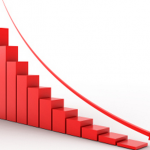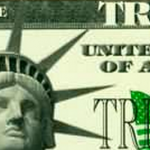When Apple Inc. (AAPL) executed the largest corporate bond offering in history at the end of April (rates were finalized on 4/30; bonds issued on 5/3), I declined to write about it because, at the time, the implications of that financial strategy were so obvious that I assumed no one would be interested in reading a blog posting regarding the topic. Since that time, two things have happened:
1) An investment professional for whom I have great respect revealed (just over a week ago) that he was not aware that AAPL’s bond offering was the largest in U.S. corporate history;
2) As the days have passed, I have become more and more aware of how seminal April 30th has become in the larger sweep of APPL’s history as a company.
For these reasons, I decided it is time to review the main threads involved within AAPL developments since one year ago.
The AAPL bond issue has tremendous significance for many more reasons than just the fact it is the largest in history. After all, AAPL being the “largest this” or “biggest that” stopped being surprising once it became (for a brief while) the “largest” company in the world over a year ago. It’s recent slide in popularity and value aside, AAPL still stands as the world’s second largest company as of last month (according to the Christian Science Monitor (http://www.csmonitor.com/Business/2013/0423/US-sweeps-list-of-the-world-s-largest-companies-Meet-the-Top-5/Apple-AAPL ). [1] AAPL is so big that its 2012 revenues were just $3.2 billion shy of the notoriously obscene revenues of XOM, and AAPL’s revenues exceeded those of retail dominator Walmart (WMT) by $26 billion! In addition, until April, AAPL had no long-term debt. Therefore, if any company was in position to extend the “world’s largest” bond offering, it was surely AAPL.
So how does the AAPL bond offering tie into other currently significant “themes” in business and investing? With the caveat that I know I am surely missing a few related themes, here are the ones I view as most important:
1) Historically low interest rates;
- Record setting corporate bond issuance
- Corporations “resetting” their financial balance – largely replacing “expensive” debt with “cheaper” debt
2) A continuing effort to “unlock shareholder value”
- Corporate share “buyback” programs
- Corporate spinoffs
- Increasing shareholder dividends.
3) Corporations caught within a worldwide recession struggling to meet the challenge of “maintaining” growth, much less increasing it
- The recession places great pressure on companies during quarterly earnings season.
- Recession or no recession, Wall Street expects GROWTH!
- Wall Street continues (for the most part) to “punish” a company’s stock price when earnings, revenues, or “guidance” disappoint.
- At those moments of disappointment, Wall Street resembles a “playboy” …. when a stock is “beautifully irresistible” in the evening light, Wall Street happily “loves them”… but upon that first disappointing look in the morning’s glare, they are very quick to “dump them”.
- At times in fact, “dump them” more closely resembles “throw them under the bus”.
4) Corporate board “activists” flexing their muscles
- This includes a seeming increase in the number of well-known hedge fund managers who are engaging in public “tugs of war” with a corporate board (Carl Icahn with Dell (DELL) and Transocean (RIG); Bill Ackman, Icahn, and others in a grudge battle over Herbalife (HLF); David Einhorn pushing Tim Cook and AAPL))
5) The IRS
- No, I am not referring to the newly uncovered IRS Scandal
- Instead, I am referring to the newly “hot” topic of foreign income “repatriation”
6) As always, institutional investors, funds and ETFs, and pension funds are required to adhere to the standards of a particular investment policy statement (ISP) and select stocks that meet certain metrics (eg. capitalization size, revenue and earnings growth rate, industry, dividend yield, etc.)
- When the financial metrics of a company change, the company’s stock will move through a period of ownership “transition”.
- “Aggressive Growth” funds must sell a stock that no longer demonstrates the expected future growth required by their ISP.
- “Income and Conservative Growth” and “Value” funds must pick up stocks that have moved into the financial or performance screens that match their ISP.
How big is “Biggest” when it comes to corporate bond issuance? In February of 2009, Roche Holding AG (ROG:VX) issued $16.5 billion in bonds, which at that time was history’s largest corporate bond deal. Other notable offerings include:
1) In 2001, France Telecom SA (FTE) issued $16.387 billion;
2) In November of last year, AbbVie Inc. (ABBV) (spinoff from ABT) offered $14.7 billion;
3) In March of 2009, Pfizer (PFE) offered $13.5 billion in bonds;
4) In January of 2009, the Citigroup (C) bond issue totaled $12 billion.
Those are all impressive numbers. AAPL toppled Roche’s record by a cool one-half billion dollars!
This bond issuance is not the first in AAPL history, but it is the first offering in almost twenty years. The total offering came in six groups, each with a different maturity and rate, as follows: [2]
1) $5.5 billion 10 years 2.40%
2) $1.5 billion 3 years 0.45%
3) $3.0 billion 30 years 3.85%
4) $4.0 billion 5 years 1.00%
5) $2.0 billion 3 years Floating Rate .05% over the 3 month LIBOR rate
6) $1.0 billion 5 years Floating Rate .25% over the 3 month LIBOR rate
Perhaps the most impressive thing about the issuance, beyond its size, was the demand for the bonds from the market. Depending upon which account you read, it was oversubscribed by anywhere between two and three times the amount offered. In fact, the demand was so great that the underwriters (prior to the finalization of rates on 4/30) reduced the original drafted rates as follows: [3]
1) 30 year: from 3.883% to 3.85%
2) 10 year: from 2.415% to 2.4%
3) 5 year: from 1.076% to 1.0%
4) 3 year: from 0.511% to 0.45%
Another surprising characteristic of this issuance is that, although AAPL has a “AA-plus” rating from Standard and Poor’s while Microsoft has an “AAA” rating, MSFT’s 10 year debt issued at nearly the same time yield 2.413%.
AAPL’s “run to debt” is just one example of a general surge in corporate debt. This month S&P reported that, during April, companies raised $326 billion in new debt — bringing the year-to-date global total to $1.2 trillion, the second-highest four-month total on record. (The record, set in 2009, is only $30 billion higher.) Other major issuers so far this year include Colgate (CL), McDonald’s (MCD), Nike (NKE) and (MSFT). One asset manager (Jason Graybill of Carret Asset Mgt LLC) echoes sentiment expressed throughout the industry: “Companies that have very little or no debt can be opportunistic when rates hit new lows…”. Perhaps even more importantly, just as is the case with homeowners carrying a mortgage rate higher than 5%, companies with higher coupon debt find it an irresistible no-brainer to refinance their debt at these historically low rates.
The next question is, if AAPL carried no long-term debt to refinance, and they sit on the biggest pile of cash in the country: “Why on earth would they borrow money, much less borrow more than any other company ever has in one giant issuance?”
The answer to that question gets to the heart of why AAPL’s bonds are an “event” – an event with deep significance and broad implications.
The biggest and most important reason for AAPL doing what amounts to an “about face” by becoming a “borrower” rather than a “cash accumulator” boils down to one unassailable point. Once AAPL’s stock price stopped its seemingly “inevitable” journey beyond $700/share toward $1000, and its “cache” in the market moved from top-notch to “second or third” (due to reduction in revenue and earnings growth and the absence of a recent, splashy, headline grabbing new product), investors became restless. By “investors”, I mean hedge funds, institutions, ETF’s, and you and me.
Every time one looked at a price chart, it was clear “something was wrong”. (Chart below from YCharts: 8/1/2012 to 4/19/2013)
Suddenly, the AAPL we had known and loved was no longer the AAPL we could count upon to move steadily upward – lower left to upper right on a price chart. (5 Year Chart below from YahooFinance)
The AAPL we had purchased for our IRA or our kids’ trust fund – because it was a “lock” to keep growing — suddenly looked like it had caught some type of disease!!
I trade online with a group of traders, several of whom are professional managers. Between September of 2012 and March of this year, I heard more comments about AAPL than any other stock. A typical comment was: “I need to avoid AAPL. I have lost more money on it than any other stock!” or “Let’s have an ‘Apple-free’ day today!”
What was going on? It can be accounted for by simple human psychology. B.F. Skinner popularized the concept of “human conditioning”. When human’s are “rewarded” for certain actions, they become trained to trust that rewards will continue to come their way if they keep repeating the same action. I grant that this is an oversimplified explanation, but please humor me for a moment. Here is how I describe the “conditioning” cycle:
1) Everything we hear and read about AAPL is exuberantly positive and even exciting!
2) We see long lines at Apple Stores when a new product is launched.
3) TV commercials regularly point out that AAPL computers are easier to use than PC’s, and don’t come with those annoying and troublesome viruses.
4) Steve Jobs – creator, founder, tech guru, design genius, billionaire, bigger than life, a “Tony Stark” without the “Iron Man” suit (but he never really wanted to save the world anyway) – can (in the eyes of the media) do no wrong. He might be the poster boy for “lionized” or “legendary”. Some of his mystic transfers to AAPL.
5) The i-Pod becomes the music device of choice; being seen with one is “cool”.
6) The i-Phone is revolutionary. Everyone raves about it. You are cool if you have one.
7) The i-Pad is revolutionary. The laptop (much less the desktop) becomes passé.
8) The new i-Phone is a “must have”.
9) CNBC spends 25% of their broadcast day raving about AAPL (OK, I exaggerate; but you get my point).
10) Investment advisers think everyone needs some AAPL.
11) Mutual funds, ETFs, hedge funds all “climb aboard” the AAPL train.
12) All the while, we “buy AAPL on dips”… and we are rewarded!!
13) AAPL becomes the biggest company in the world.
14) AAPL becomes such a big percentage of the NASDAQ 100 Index that many start calling NASDAQ the APPLEDAQ.
15) Every time you look at the price chart… it is steadily left to right upward-biased. It could become the “Buzz Lightyear” stock – “to infinity and beyond”.
16)We are convinced that AAPL is “set apart”, “different”, in a “class of its own”.
For a large group of folks (including me and the traders with whom I interact), AAPL became something akin to an addiction. We had been so “conditioned” to believe in its success that we kept treating it as a “sure thing” long after it had fallen from grace. Some “tip offs” we missed that should have cooled our AAPL addiction included:
1) a steady increase in AAPL criticism once Jobs was dead and buried;
2) stories that Tim Cook doesn’t have “what it takes” to keep AAPL strong;
3) Dinner conversations with your junior and senior high kids, desperately begging for the “cool new Samsung Galaxy smartphone – everyone has one!”
4) Android phones’ market share exceeding that of the i-Phone.
But conditioning is difficult to repress! We kept on counting on the roll-out of an irresistible new product – a TV, a watch, an iPhone with a bigger screen, … anything! But it never came. All the while that I, my colleagues, and countless others, counted on “our” AAPL to perform as it always had in recent years, the AAPL stock price was instead engaged in an incredible, precipitous fall (from “grace” and from $700). This small worksheet summarizes the initial acceleration in the velocity of the fall, followed by two slightly slower periods of continued descent (to $385)…. for a cumulative decline of over 45%… in just over 130 trading days.
Worksheet above was created from data accessed through YahooFinance by the author.
Meanwhile, the much more dispassionate hedge fund and institutional/fund managers had been unloading AAPL from $700 all the way down to $385. Did we feel like chumps, or what!??
Wall Street did not react well to an emerging trend in AAPL’s diluted quarterly earnings per share – three straight quarters of decrease (see chart). The “last straw” came when Q1 of 2013 showed the first quarter over quarter earnings decline in ten years, and the slowest rate of revenue growth in years. In fact, since Q3 of 2012, revenue growth had slowed to a pace last seen at the height of the mortgage crisis recession.
GRAPH above shows AAPL’s diluted EPS in blue. 2012 saw three straight decreases. Note that before 2012, the trend was fairly steadily upward, while the trend for GOOG was flatter and the trend for PCLN was erratic. (Credit: Ycharts.com)
As a consequence, during these months the AAPL conversation not so subtly turned from “growth stories” to “don’t forget that AAPL has over $200 per share in cash – so it is dirt cheap!” That evolved into various “plans” created by people outside of AAPL regarding how AAPL should maximize its mountain of cash. The general consensus was that AAPL’s concession in mid-2012 to start paying a dividend was not nearly enough.
Graph above: It was big news when AAPL started to pay a dividend in mid 2012. But for many institutional investors, that just wasn’t enough! (Credit: Ycharts.com)
Earlier this year, infamous hedge fund manager David Einhorn publically confronted Tim Cook with an elaborate plan for AAPL to create a special class of preferred shares, through which it could begin using its cash to “unlock value” (and make hedge funds richer). The plan was controversial, but prompted weeks of intriguing dialogue outside of AAPL. We all waited to hear what AAPL would do, hoping for good news.
In Part II, we will explore in detail the response that Tim Cook and AAPL made to its shunning by Wall Street, the criticism of David Einhorn, and the deep disappointment felt by you and me.
Submitted by Thomas Petty
[1] For those interested, Exxon-Mobil (XOM) is first; Google (GOOG) is third; Berkshire Hathaway (BRK-B) is fourth; and Walmart (WMT) is fifth.
[2] This breakdown is in accordance with Morningstar’s posted analysis at http://quicktake.morningstar.com/StockNet/bonds.aspx?symbol=AAPL
Note that it differs from other lists I have seen on the web. If you want precise figures, I suggest you perform your own due diligence.
[3] Once again, I repeat the caveat offered in footnote 2. There was DEFINITELY a re-pricing by the underwriters following the pre-issuance survey of potential buyers they completed. The re-pricing significantly lower rates. Precisely how much is evidently a matter on which sources differ.
Related Posts
Also on Market Tamer…
Follow Us on Facebook

 We're About to Find Out the Answer to Warren Buffett's Pointed Question About Trump's Tariffs. Here Are 3 Stocks to Buy Depending on What That Answer Is.
We're About to Find Out the Answer to Warren Buffett's Pointed Question About Trump's Tariffs. Here Are 3 Stocks to Buy Depending on What That Answer Is.



